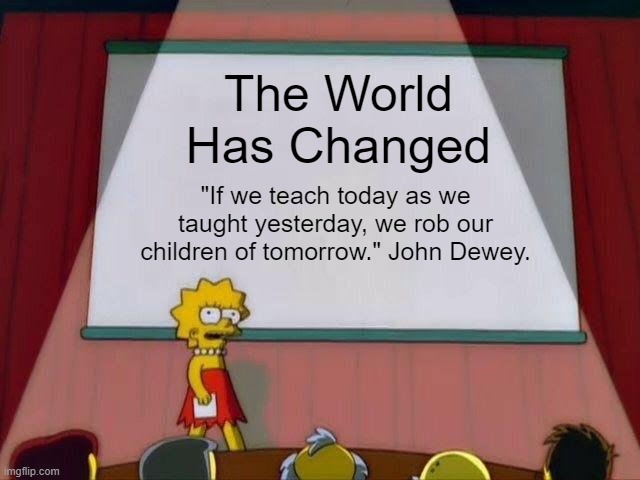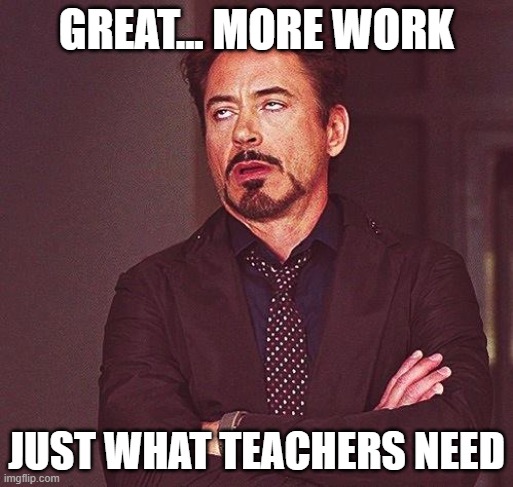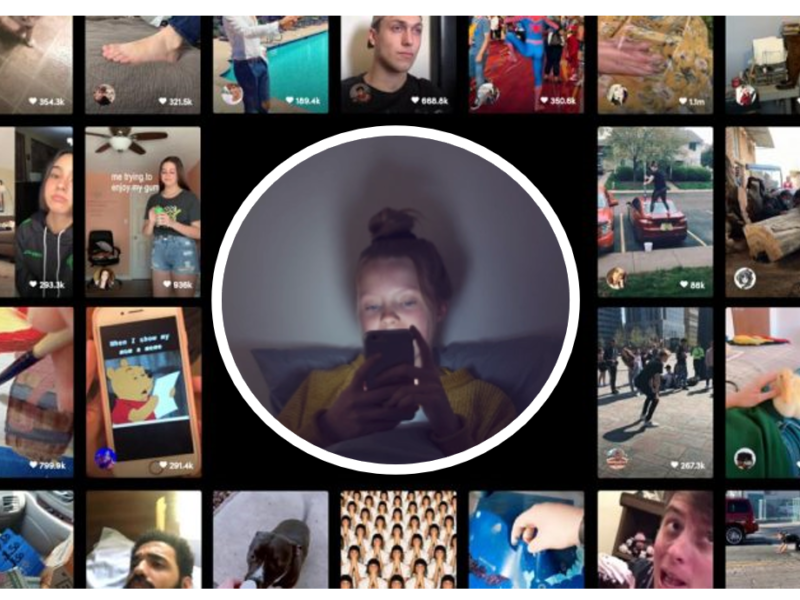Teachers, if you responded like the meme above, I need to clarify. I am not proposing hosting Fortnite tournaments in English, perfecting TikTok dances in Social Studies or adding views to ‘Baby Shark’ in Math.
In fact, I follow the research of NYU psychologist Jonathan Haidt in advocating for school-wide bans on student phones during class time (1).
So, how do I justify my title? I promise it’s not clickbait.
I believe the key to unlocking the enormous learning potential in topics as diverse as Minecraft, TikTok and YouTube is not consuming them in class-time – it’s studying them. The key is separating skills from content.
This may sound simple but too often learning materials undermine the teaching of vital literacy, numeracy and critical thinking skills by bundling them with content that is unengaging, outdated and/or plain confusing.
New Curriculum for New Realities
In the past twenty years, technology has changed the way we live, work, and play. The response to COVID-19 has dramatically sped up the adaptation of digital technologies by as much as ten years. (2)
While many teachers have been asked to deliver their curriculum digitally, the same attention has not been placed on the content of lessons. This is a problem.
Young people growing up today are “part of a unique generation… where the use of digital screens is intensive and pervasive”. (3) Social media apps, game developers and video-streaming companies aggressively and successfully target children, tweens and teens. (4)

Teachers need new curriculum for this new reality, both to build up young people’s defences against highly addictive applications (4) and also to embed critical literacy and numeracy skills in engaging and relevant contexts.
Young people are evolutionarily programmed to efficiently learn about concepts they see as meaningful to their lives. (5) Exploring these concepts is an enormous teaching and learning opportunity.
Challenges
So why don’t more teachers incorporate content on TikTok, YouTube and videogames in their classes?
The obstacle is not a lack of awareness. Teachers are uniquely positioned to see how a class comes alive when the topic being discussed is of interest to students. Similarly, as teachers we understand that disengaged students make our jobs harder and less fulfilling.
The truth is teachers do not have the time to research, investigate and adapt learning materials to the shifting touchpoints of young people’s lives.
Many full-time teachers are already at capacity with the ever-expanding scope of our role, especially in the wake of the highly disrupted 2020 and 2021 school years. (6)

While some teachers spend weekends, late nights and early mornings trying to produce a stream of relevant content, having done this myself for a number of years I can attest that this is unsustainable.
Developing lessons under intense pressure does not lead to best practice materials. It also produces weary, over-worked teachers who do not have the time to provide the careful coaching and feedback every student needs.
A Path Forward…
One potential solution is to encourage teachers to outsource some of the burden of resource creation.
This does not negate teachers’ essential work in selecting, shaping, and delivering materials to best suit the needs of their learners. Instead, it acknowledges the impossibility of adapting often decades out-of-date material overnight.
For the past eighteen months I have taken some dedicated time outside the classroom to research, create, test and publish high-interest units and lessons that can be delivered by busy teachers digitally and/or in person.
Videogames, TikTok and YouTube are fascinating topics to explore in the classroom. There is a wonderful synergy when students see their own passions reflected in learning content.
It is also deeply empowering for teachers to have ready-made lessons to guide students to critically study the companies and algorithms that have such a huge impact on their lives – for better and/or for worse.
The world has changed. Now our curriculum needs to!
Happy Teaching,
Michael
This is my first post! Sign up to the newsletter for a monthly post and leave some feedback. Did I convince you? Were you already on-side? Unconvinced? Whatever the case I’d love to hear from you and start a conversation.
If you’d like to check out my work I’m on TeachersPaysTeachers and YouTube as ‘Growth Through the Middle Years’.
Resources most closely aligned to this post:
- Gaming & Technology Informational Text Bundle
- COMPLETE Bundle of Informational Texts
- Review ANY Videogame
- Review Writing Bundle
References
(1) https://your-undivided-attention.simplecast.com/episodes/are-the-kids-alright
(3) https://link.springer.com/article/10.1007/s00127-019-01825-4
(5) https://www.universityofcalifornia.edu/news/evolutionary-advantage-teenage-brain
(6) https://www.nytimes.com/2020/11/30/us/teachers-remote-learning-burnout.html



Interesting ideas. I agree there is a real need to update resources so they engage with the world today – but a real challenge is how fast things are changing! I have middle schoolers who are ‘interested in crypto’ and discussing NFT’s. As an educated adult these concepts are really complicated to understand (might just be me?). I also hope that rigor is not lost, kids still need to read, write and be numerate. Often a ‘boring’ resource that has solid foundations will be more successful in the long term than something that might be more engaging but not have the same depth. Just my two cents, interesing read.
Thanks for the comments Matt! Absolutely the pace of change at the moment is really challeneging. It’s fantastic to hear your students are talking about and engaging with these concepts, as challenging as they are. Absolutely, resources need sound foundations – as you identify – I have also seen how combining sound foundations with highly engaging topics and prompts can produce exceptional results. Not only is the quality of student work much higher but behaviour is significantly improved as students see the purpose to what they are doing. This makes teaching much more enjoyable and will hopefully keep more of us in the profession. That noted I agree we don’t want to ‘throw out the baby with the bathwater’ and lose the brilliant work of so many educators over previous decades trying to update everything at once.
Beast